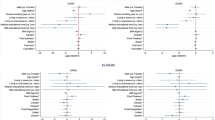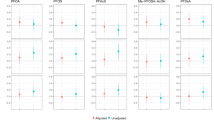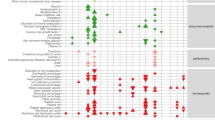Abstract
Objective:
To examine the coherence of estimated intakes of acrylamide (AA) from foods, with hemoglobin (Hb) AA adduct levels, an objective marker of environmental AA exposure.
Design:
A cross-sectional study.
Setting:
The Malmö Diet and Cancer study, a large population-based prospective cohort (n=28 098) in the south of Sweden.
Subjects:
A sample of non-smoking (n=70) and smoking (n=72) women and men selected to obtain large variation in Hb AA adducts.
Methods:
Self-reported data on the usual consumption of foods were combined with published data on the AA content in Swedish foods. The Hb AA adduct levels were determined by a modified Edman degradation method. Linear regression and correlation analysis examined associations between estimated AA intakes, and Hb AA adducts.
Results:
In randomly selected individuals (n=40), the estimated median AA intake was 28 μg per day. In linear regression models, adjusting for sex, significant associations were seen in non-smokers between Hb AA adducts and estimated AA from foods (P=0.006). In smokers both AA from foods (P=0.006) and the calculated amount of tobacco consumed (P=0.003) were significantly associated with Hb AA adducts. Positive partial correlations between dietary AA estimates and Hb AA adducts were seen in smoking men (r=0.37) and women (r=0.59), and in non-smoking men (r=0.60), but not in non-smoking women.
Conclusions:
This study suggests that both diet and tobacco are important sources of the environmental AA exposure, although the lack of correlations in non-smoking women cast doubt on the validity of dietary AA intake estimates used in cancer epidemiology, or suggest that unrecognized factors may influence the internal dose measure of AA exposure.
Sponsorship:
Funded by the Swedish Research Council for Environment, Agricultural Sciences and Spatial Planning (FORMAS); the European Commission (Contract no FOOD-CT-2003–506820, HEATOX); The Swedish Cancer Society; The Swedish Research Council; and The City of Malmö.
This is a preview of subscription content, access via your institution
Access options
Subscribe to this journal
Receive 12 print issues and online access
$259.00 per year
only $21.58 per issue
Buy this article
- Purchase on Springer Link
- Instant access to full article PDF
Prices may be subject to local taxes which are calculated during checkout





Similar content being viewed by others
References
Abdulla M, Andersson I, Asp NG, Berthelsen K, Birkhed D, Dencker I et al. (1981). Nutrient intake and health status of vegans. Chemical analyses of diets using the duplicate portion sampling technique. Am J Clin Nutr 34, 2464–2477.
Berglund G, Elmståhl S, Janzon L, Larsson SA (1993). The Malmö Diet and Cancer study: design and feasibility. J Intern med 233, 45–51.
Bergmark E (1997). Hemoglobin adducts of acrylamide and acrylonitrile in laboratory workers, smokers, and nonsmokers. Chem Res Toxicol 10, 78–84.
Bergmark E, Calleman C-J, He F, Costa LG (1993). Determination of hemoglobin adducts in humans occupationally exposed to acrylamide. Toxicol Appl Pharmacol 120, 45–54.
Bjellaas T, Janak K, Lundanes E, Kronberg L, Becher G (2005). Determination and quantification of urinary metabolites after dietary exposure to acrylamide. Xenobiotica 35, 1003–1018.
Black AE, Goldberg GR, Jebb SA, Livingstone MBE, Cole TJ, Prentice AM (1991). Critical evaluation of energy intake data using fundamental principles of energy physiology: 2. Evaluating the results of published surveys. Eur J Clin Nutr 45, 583–599.
Boettcher MI, Schettgen T, Kütting B, Pitschetsrieder M, Angerer J (2005). Mercapturic acids of acrylamide and glycidamide as biomarkers of the internal exposure to acrylamide in the general population. Mutat Res 580, 167–176.
Callmer E, Riboli E, Saracci R, Åkesson B, Lindgärde F (1993). Dietary assessment methods evaluated in the Malmö food study. J Intern Med 233, 53–57.
CIAA (2005). CIAA Acrylamide ‘Toolbox’, vol. 2005. CIAA (Confederation of The Food and Drinks Industries of the EU). Brusells: Belgium.
Dybing E, Farmer PB, Andersen M, Fennell TR, Lalljie SP, Muller DJ et al. (2005). Human exposure and internal dose assessments of acrylamide in food. Food Chem Toxicol 43, 365–410.
Dybing E, Sanner T (2003). Risk assessment of acrylamide in foods. Toxicol Sci 75, 7–15.
Eriksson S, Karlsson P, Törnqvist M (2007). Measurement of evaporated acrylamide during heat treatment of food and other biological materials. LWT – Food Sci Technol 40, 706–712.
European Commission (1998). European Council Directive 98/83/EC of 3 November 1998 of the quality of water intended for human consumption. Official Journal of the European Communities, L330, 05/12/1998, pp 32–54.
European Commission (2002). European Commission Directive 2002/72/EC of 6 August 2002 relating to plastic materials and articles intended to come into contact with foodstuffs. Official Journal of the European Communities, L220, 15/08/2002, pp 18–58.
European Union (2002). European Union risk assessment report acrylamide. European Commision, Office for Official Publications of the European Communities, Luxemburg, 2002, PL-1,Vol. 24, 1–207.
FAO/WHO/UNU (1985). Energy and Protein Requirements Report of a Joint FAO/WHO/UNU Expert consultation. World Health Organization: Geneva.
Fennell TR, Sumner SCJ, Snyder RW, Burgess J, Spicer R, Bridson WE, et al. (2005). Metabolism and hemoglobin adduct formation of acrylamide in humans. Toxicol Sci 85, 447–459.
Fuhr U, Boettcher MI, Kinzig-Schippers M, Weyer A, Jetter A, Lazar A et al. (2006). Toxicokinetics of acrylamide in humans after ingestion of a defined dose in a test meal to improve risk assessment for acrylamide carcinogenicity. Cancer Epidemiol Biomarkers Prev 15, 266–271.
Goldberg GR, Black AE, Jebb SA, Cole TJ, Murgatroyd PR, Coward WA et al. (1991). Critical evaluation of energy intake data using fundamental principles of energy physiology: 1. Derivation of cutoff limits to identify under-recording. Eur J Clin Nutr 45, 569–581.
Granby K, Fagt S (2004). Analysis of acrylamide in coffee and dietary exposure to acrylamide from coffee. Anal Chim Acta 520, 177–182.
Hagmar L, Törnqvist M (2003). Inconclusive results from an epidemiological study on dietary acrylamide and cancer. Br J Cancer 89, 774–775.
Hagmar L, Törnqvist M, Nordander C, Rosén I, Bruze M, Kautiainen A et al. (2001). Health effects of occupational exposure to acrylamide using haemoglobin adducts as biomarker of internal dose. Scand J Work Environ Health 27, 219–226.
Hagmar L, Wirfält E, Paulsson B, Törnqvist M (2005). Differences in hemoglobin adduct levels of acrylamide in the general population with respect to dietary intake, smoking habits and gender. Mutat Res 580, 157–165.
IARC (1994). Acrylamide, Vol. 60. Lyon:France.
Jones K, Garfitt S, Emms V, Warren N, Cocker J, Farmer P (2006). Correlation of haemoglobin-acrylamide adducts with airborne exposure: an occupational survey. Toxicol Lett 162, 174–180.
Kütting B, Schettgen T, Beckmann MW, Angerer J, Drexler H (2005). Influence of diet on exposure to acrylamide--reflections on the validity of a questionnaire. Ann Nutr Metabol 49, 173–177.
Lightowler HJ, Davies GJ (2002). Assessment of iodine intake in vegans: weighed dietary record vs duplicate portion technique. Eur J Clin Nutr 56, 765–770.
Manjanatha MG, Aidoo A, Shelton SD, Bishop ME, McDaniel LP, Lyn-Cook LE et al. (2006). Genotoxicity of acrylamide and its metabolite glycidamide administered in drinking water to male and female Big Blue mice. Environ Mol Mutagen 47, 6–17.
Mucci LA, Adami H-O, Wolk A (2006). Prospective study of dietary acrylamide and risk of colorectal cancer among women. Int J Cancer 118, 169–173.
Mucci LA, Dickman PW, Steineck G, Adami H-O, Augustsson K (2003). Dietary acrylamide and cancer of the large bowel, kidney and bladder: absence of an association in a population-based study in Sweden. Br J Cancer 88, 84–89.
Mucci LA, Lindblad P, Steineck G, Adami H-O (2004). Dietary acrylamide and risk of renal cell cancer. Int J Cancer 109, 774–776.
Mucci LA, Sandin S, Bälter K, Magnusson C, Weiderpass E, Adami H-O (2005). Acrylamide intake and breast cancer risk in a large, prospective study among Swedish women. JAMA 293, 1295–1296.
Pelucchi C, Franceschi S, Levi F, Trichopoulos D, Bosetti C, Negri E et al. (2003). Fried potatoes and human cancer. Int J Cancer 105, 558–560.
Pelucchi C, La Vecchia C, Franceschi S, Levi F (2004). Letter to the Editor: fried potatoes and human cancer. Int J Cancer 108, 636–637.
Pero RW, Olsson A, Bryngelsson C, Carlsson S, Janzon L, Berglund G et al. (1998). Quality control program for storage of biologically banked blood specimens in the Malmö Diet and Cancer Study. Cancer Epidemiol Biomarker Prev 7, 803–808.
Riboli E, Elmståhl S, Saracci R, Gullberg B, Lindgärde F (1997). The Malmö food study: validity of two dietary assessment methods for measuring nutrient intake. Int J Epidemiol 26, S161–S173.
Rice JM (2005). The carcinogenicity of acrylamide. Mutat Res 580, 3–20.
Rosén J, Hellenäs K-E (2002). Analysis of acrylamide in cooked foods by liquid chromatography tandem mass spectrometry. The Analyst 127, 880–882.
Schettgen T, Rossbach B, Kütting B, Letzel S, Drexler H, Angerer J (2004). Determination of haemoglobin adducts of acrylamide and glycidamide in smoking and non-smoking persons of the general population. Int J Hyg Environ Health 207, 531–539.
Sörgel F, Weissenbacher R, Kinzig-Schippers M, Hofmann A, Illauer M, Skott A et al. (2002). Acrylamide: increased concentrations in homemade food and first evidence of its variable absorption from food, variable metabolism and placental and breast milk transfer in humans. Chemotherapy 48, 267–274.
SPSS (2001). SPSS for Windows Professional Statistics Release 11.0. SPSS Inc.: Chicago IL, USA.
Svensson K, Abramsson L, Becker W, Glynn A, Hellenäs K-E, Lind Y et al. (2003). Dietary intake of acrylamide in Sweden. Food Chem Toxicol 41, 1581–1586.
Tareke E, Rydberg P, Karlsson P, Eriksson S, Tornqvist M (2002). Analysis of acrylamide, a carcinogen formed in heated foodstuffs. J Agric Food Chem 50, 4998–5006.
Tareke E, Rydberg P, Karlsson P, Eriksson S, Törnqvist M (2000). Acrylamide: a cooking carcinogen? Chem Res Toxicol 13, 517–522.
Törnqvist M, Bergmark E, Ehrenberg L, Granath F (1998). Riskbedömning av acrylamide (Risk assessment of acrylamide) (in Swedish). Kemikalieinspektionen: Solna, Solna, Sweden, 28pp.
Törnqvist M, Fred C, Haglund J, Helleberg H, Paulsson B, Rydberg P (2002). Protein adducts: quantitative and qualitative aspects of their formation analysis and applications. J Chromatogr B 778, 279–308.
Törnqvist M, Mowrer J, Jensen S, Ehrenberg L (1986). Monitoring of environmental cancer initiators through hemoglobin adducts by a modified Edman degradation method. Ann Biochem 154, 255–266.
Törnqvist M, Paulsson B, Osterman-Golkar S (2006). 8. Biomonitoring of acrylamide and its metabolites. In: Skog K, Alexander J (eds). Acrylamide and other hazardous compounds in heat-treated foods. Woodhead Publishing Limited: Cambridge, pp. 163–194.
Vainio H (2003). Acrylamide in heat-processed foods - a carcinogen looking for human cancer? Eur J Cancer 18, 1105–1106.
Vesper HW, Lizea-Perez H, Meyers T, Ospina M, Myers GL (2005). Pilot study on the impact of potato chips consumption on biomarkers of acrylamide exposure. In: Mottram D, Friedman Ma (eds). Chemistry and Safety of Acrylamide in Food, Vol. 561. Springer Science and Business Media Inc: New York, pp. 89–96.
Vikström A, Eriksson S, Paulsson B, Karlsson P, Törnqvist M (2005). Comparison of bioavailability from different foods – A study in mice. In: Eriksson S, Doctoral Thesis (eds). Acrylamide in Food Products: Identification, Formation and Analytical Methodology. Stockholm University: Stockholm.
Vittinghoff E, Glidden DV, Shiboski SC, McCulloch CE (2005). Regression Methods in Biostatistics. Springer: New York.
Willett W (1998). Nutritional Epidemiology, 2nd edition. Oxford University Press: New York Oxford, pp. 101–147.
World Health Organisation WHO (2002). Health Implications of Acrylamide in Food. WHO, Department of Protection of the Human Environment: Geneva.
Author information
Authors and Affiliations
Corresponding author
Additional information
Contributors: All authors have contributed substantially to the interpretation of findings and to the write-up of the paper. LH initiated and designed the project; EW conducted all statistical analyses and wrote most of the paper; BP and MT were responsible for the biochemical analyses; and AA provided statistical support and advice.
Rights and permissions
About this article
Cite this article
Wirfält, E., Paulsson, B., Törnqvist, M. et al. Associations between estimated acrylamide intakes, and hemoglobin AA adducts in a sample from the Malmö Diet and Cancer cohort. Eur J Clin Nutr 62, 314–323 (2008). https://doi.org/10.1038/sj.ejcn.1602704
Received:
Revised:
Accepted:
Published:
Issue Date:
DOI: https://doi.org/10.1038/sj.ejcn.1602704
Keywords
This article is cited by
-
A systematic review: on the mercaptoacid metabolites of acrylamide, N-acetyl-S-(2-carbamoylethyl)-L-cysteine
Environmental Science and Pollution Research (2023)
-
Dietary acrylamide exposure was associated with increased cancer mortality in Chinese elderly men and women: a 11-year prospective study of Mr. and Ms. OS Hong Kong
Journal of Cancer Research and Clinical Oncology (2017)
-
Dietary and lifestyle determinants of acrylamide and glycidamide hemoglobin adducts in non-smoking postmenopausal women from the EPIC cohort
European Journal of Nutrition (2017)
-
Challenges in estimating the validity of dietary acrylamide measurements
European Journal of Nutrition (2013)
-
Dietary acrylamide intake of adults in the European Prospective Investigation into Cancer and Nutrition differs greatly according to geographical region
European Journal of Nutrition (2013)



